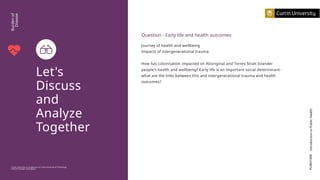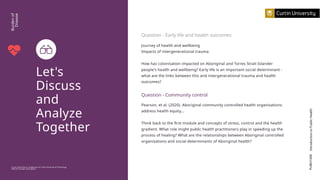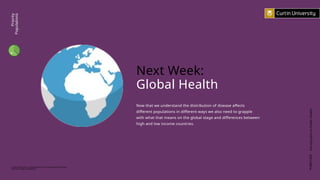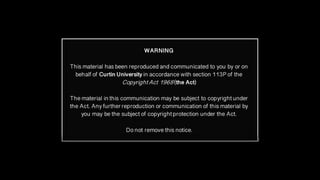PUBH1000 - Module 5: Priority Populations
- 1. Introduction to Public Health Curtin School of Population Health PUBH1000 Module 5: Priority Populations
- 2. Curtin University is a trademark of Curtin University of Technology CRICOS Provider Code 00301J We acknowledge the Whadjuk people of the Nyungar nation on whose land we are gathered and pay our respects to elders past and present. As representatives of Curtin University we are proud to honour the Nyungar people and value this place of shared learning. We recognise the impacts of colonisation on Indigenous Australians and as active participants in reconciliation we are committed to moving forward together in a spirit of mutual honour and respect. PUBH1000 Introduction to Public Health Priority Populations
- 3. Welcome to today's class! 01 02 03 04 05 Acknowledgement of country Module learning outcomes Group presentations Zombie apocalypse closing Reflections and discussion Today's Agenda PUBH1000 Introduction to Public Health Priority Populations Curtin University is a trademark of Curtin University of Technology CRICOS Provider Code 00301J
- 4. Learning Outcomes ŌĆó Describe the social, colonial, economic and cultural determinants of the health of Aboriginal and Torres Strait Islander peoples in Australia. ŌĆó Define and distinguish marginality, intersectionality, social exclusion and social inclusion. ŌĆó Understand how various categories of oppression interact and contribute to systemic social inequality. PUBH1000 Introduction to Public Health Curtin University is a trademark of Curtin University of Technology CRICOS Provider Code 00301J Priority Populations
- 5. PUBH1000 Introduction to Public Health Curtin University is a trademark of Curtin University of Technology CRICOS Provider Code 00301J WARNING: Requires students to present to class Z O M B I E S Y NTH ESI S A P O C A L Y P S E
- 6. Scenario based learning Interrogate the scenario to identify knowledge gaps and develop questions that need to be answered to progress a response. Catalyst Explore research literature and data to find answers to help understand the complexities in the scenario. Discovery Consolidate research findings to help explain the scenario and develop potential public health responses. Synthesis PUBH1000 Introduction to Public Health Curtin University is a trademark of Curtin University of Technology CRICOS Provider Code 00301J zombie apocalypse
- 7. Public Health Challenge Group 1 What is a virus? What are zoonotic diseases? What were the origins and transmission modes of Ebola and Zika in recent outbreaks? zombie apocalypse Curtin University is a trademark of Curtin University of Technology CRICOS Provider Code 00301J PUBH1000 Introduction to Public Health
- 8. Public Health Challenge Group 2 What are the differences and similarities in the health system models of Australia, Taiwan, Germany and the United States of America? zombie apocalypse Curtin University is a trademark of Curtin University of Technology CRICOS Provider Code 00301J PUBH1000 Introduction to Public Health
- 9. Public Health Challenge Group 3 What are the International Health Regulations and what do they do? What powers do emergency declarations provide governments in controlling disease outbreaks in Australia? zombie apocalypse Curtin University is a trademark of Curtin University of Technology CRICOS Provider Code 00301J PUBH1000 Introduction to Public Health
- 10. Public Health Challenge Group 4 How do vaccines work? What are the causes of vaccine hesitancy? How should public health practitioners respond to vaccine hesitancy? zombie apocalypse Curtin University is a trademark of Curtin University of Technology CRICOS Provider Code 00301J PUBH1000 Introduction to Public Health
- 11. Public Health Challenge Group 5 What impact does stigma have on our ability to control infectious diseases? How do we prevent or reduce stigma and discrimination against people and/or communities affected by an infectious disease? zombie apocalypse Curtin University is a trademark of Curtin University of Technology CRICOS Provider Code 00301J PUBH1000 Introduction to Public Health
- 12. Scenario Closure Vaccination prevents an estimated 650,000 cases of Z-21 re-animation in each annual global birth cohort since its distribution commenced. In October 2024, the World Health Organization (WHO) declares the Western Pacific region, including Australia to be Z-21-free. This marks an important achievement for human health and is a true vaccination 'success story.' Since the creation of the Global Z-21 Eradication Initiative by the World Health Assembly in 2020, the estimated number of Z- 21 cases has fallen from 350,000 to less than 3,500, a decrease of more than 99 percent. Unfortunately, it has remained endemic in two countries: Estonia and Finland. [1] This is not something that is merely happening to us, a cosmic misfortune, a one-off event over which we must get up on our hind legs and howl at our governments for insufficient diligence. It is, on the contrary, a result of things we do as a modern societyŌĆötraveling, transporting people and things speedily around the globe, having babies to the point where there are more than seven billion of us on this planet, so that we now represent an irresistible resource for any virus that can adapt to preying upon usŌĆöand itŌĆÖs part of a longer, broader pattern. In 2012, MERS coronavirus emerged from Saudi Arabia, stirring our concerns. In 2014 it was Ebola, blazing out of West Africa in search of a larger host base. In 2016 it was Zika linked to an epidemic of birth defects in Brazil. In 2020 it was COVID-19 emerging from China and crossing the world. Right now it is Z-21. Next year it will be virus X, and the year after, virus Y. We must be ready. [2] Quoted and adapted from: ŌĆó Roche, P. & Spencer, J. (2002) Editorial: Polio eradication in Australia and the world. Communicable Diseases Intelligence, 26(2). ŌĆó Quammen, D. (2016) Why Zika Is This YearŌĆÖs Scary Virus. National Geographic. Retrieved from: https://www.nationalgeographic.com/science/article/160128-zika-virus-birth-defects-brian-damage-history-science zombie apocalypse PUBH1000 Introduction to Public Health Curtin University is a trademark of Curtin University of Technology CRICOS Provider Code 00301J Curtin University is a trademark of Curtin University of Technology CRICOS Provider Code 00301J
- 13. Let's Discuss and Analyze Together PUBH1000 Introduction to Public Health Curtin University is a trademark of Curtin University of Technology CRICOS Provider Code 00301J Burden of Disease Journey of health and wellbeing Impacts of intergenerational trauma How has colonisation impacted on Aboriginal and Torres Strait Islander people's health and wellbeing? Early life is an important social determinant - what are the links between this and intergenerational trauma and health outcomes? Question - Early life and health outcomes
- 14. Let's Discuss and Analyze Together PUBH1000 Introduction to Public Health Curtin University is a trademark of Curtin University of Technology CRICOS Provider Code 00301J Burden of Disease Pearson, et al. (2020). Aboriginal community controlled health organisations address health equity... Think back to the first module and concepts of stress, control and the health gradient. What role might public health practitioners play in speeding up the process of healing? What are the relationships between Aboriginal controlled organisations and social determinants of Aboriginal health? Question - Community control Journey of health and wellbeing Impacts of intergenerational trauma How has colonisation impacted on Aboriginal and Torres Strait Islander people's health and wellbeing? Early life is an important social determinant - what are the links between this and intergenerational trauma and health outcomes? Question - Early life and health outcomes
- 15. PUBH1000 Introduction to Public Health Curtin University is a trademark of Curtin University of Technology CRICOS Provider Code 00301J Next Week: Global Health Now that we understand the distribution of disease affects different populations in different ways we also need to grapple with what that means on the global stage and differences between high and low income countries. Priority Populations
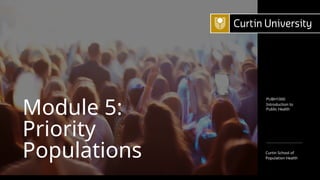
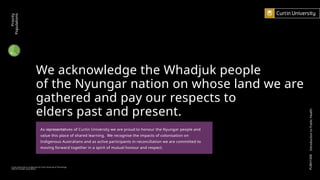
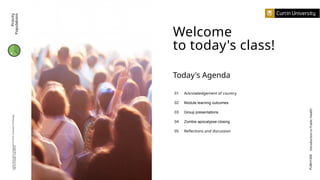
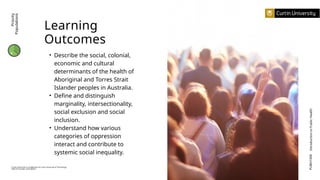


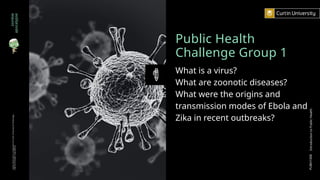
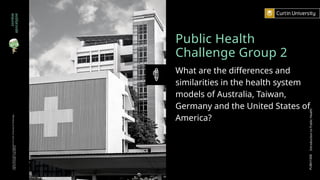
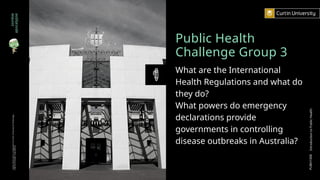
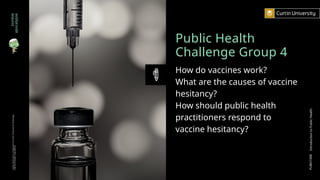
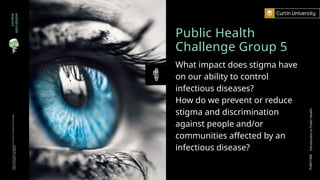
![Scenario Closure
Vaccination prevents an estimated 650,000 cases of Z-21 re-animation in each annual global birth
cohort since its distribution commenced. In October 2024, the World Health Organization (WHO)
declares the Western Pacific region, including Australia to be Z-21-free. This marks an important
achievement for human health and is a true vaccination 'success story.' Since the creation of the
Global Z-21 Eradication Initiative by the World Health Assembly in 2020, the estimated number of Z-
21 cases has fallen from 350,000 to less than 3,500, a decrease of more than 99 percent.
Unfortunately, it has remained endemic in two countries: Estonia and Finland. [1]
This is not something that is merely happening to us, a cosmic misfortune, a one-off event over which
we must get up on our hind legs and howl at our governments for insufficient diligence. It is, on the
contrary, a result of things we do as a modern societyŌĆötraveling, transporting people and things
speedily around the globe, having babies to the point where there are more than seven billion of us
on this planet, so that we now represent an irresistible resource for any virus that can adapt to
preying upon usŌĆöand itŌĆÖs part of a longer, broader pattern. In 2012, MERS coronavirus emerged from
Saudi Arabia, stirring our concerns. In 2014 it was Ebola, blazing out of West Africa in search of a
larger host base. In 2016 it was Zika linked to an epidemic of birth defects in Brazil. In 2020 it was
COVID-19 emerging from China and crossing the world. Right now it is Z-21. Next year it will be virus
X, and the year after, virus Y. We must be ready. [2]
Quoted and adapted from:
ŌĆó Roche, P. & Spencer, J. (2002) Editorial: Polio eradication in Australia and the world. Communicable Diseases Intelligence, 26(2).
ŌĆó Quammen, D. (2016) Why Zika Is This YearŌĆÖs Scary Virus. National Geographic. Retrieved from: https://www.nationalgeographic.com/science/article/160128-zika-virus-birth-defects-brian-damage-history-science
zombie
apocalypse
PUBH1000
Introduction
to
Public
Health
Curtin University is a trademark of Curtin University of Technology
CRICOS Provider Code 00301J
Curtin University is a trademark of Curtin University of Technology
CRICOS Provider Code 00301J](https://image.slidesharecdn.com/m5tutes12025-250320082050-e526ce46/85/PUBH1000-Module-5-Priority-Populations-12-320.jpg)
